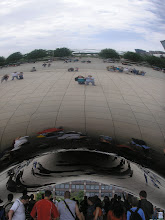Louis Spohr lies in an interesting place in music history in that his early symphonies fall in the Classical period, while the later symphonies fall in the Romantic period. Of course this is not a unique trait of Spohr’s- Beethoven immediately comes to mind as being in the same musical position. I believe what makes Spohr lesser known, for the most part, is that while Beethoven, as well as other Romantic composers, were pressing forward, Spohr was stuck in the past.
As Hannah states toward the end of her entry, I felt that Mendelssohn must have been a major influence on Louis Spohr. Like Mendelssohn, Spohr started his composition career by defying his parents’ wishes and attending music school, and also had great interest in looking back at the composers of the past. It is this interest in looking studying past musical styles that led Spohr to compose his “Symphony No. 6 Historische im Stil und Geschmack vier verschiedener Zeitabschnitte,” also known as the “Historical Symphony.”
Spohr’s symphony is divided into four movements, each one written in homage to a different musical period. The first movement, titled “Bach- Handel’sche Periode,” is a reference to the Baroque style. The second movement, “Haydn- Mozart’sche Periode,” depicts the Classical style. The third movement, “Beethoven’sche Periode,” is a portrayal of the Romantic period. Finally, the fourth movement, “Allerneueste Periode,” is Spohr’s view of the “new music” at the time the piece was written in 1839.
The first movement is clearly written in the Bach fugal style. String sections and winds continuously follow each other through the fugal themes. While the winds do sound in accordance with Bach-Handel style, with flute, oboe, and bassoon, it is easy to hear that the strings are too heavily scored. This allows for what I feel is too much dynamic contrast for a Baroque piece, from soft solo oboe statements, to exclamatory tutti orchestra sections. In addition, I felt several times that I heard harmonies that were too chromatic to be put in the Baroque style.
The second movement contrasted with the first in many of the ways one would expect a Classical piece to contrast with a Baroque piece. Rather than continuous, steadily-moving fugal themes shared by the whole orchestra, this movement in the style of Haydn and Mozart incorporated much more tuneful melodies and rhythmic diversity that helped to keep the listener’s attention. Although, I do agree with Hannah in that the movement was still scored to heavily in the strings. Again, as with the first movement, I felt that there was some underlying harmonic chromaticism which felt out of place. I would be interested to know if these may have been the same instances Hannah heard as Spohr’s “use of experimental harmonies.”
The symphony’s third movement was definitely the most exciting. Spohr’s use of dynamic contrast is most effective in this movement, gaining the listener’s ear with a soft, driving beat in the timpani, and building to a melodic climax with the tutti orchestra. Spohr effectively captures the Romantic spirit of Beethoven. This movement ultimately sounds the most natural of the four in this work, leading me to believe Louis Spohr truly was a Romantic composer at heart.
As for the fourth movement, I share in Hannah’s confusion. It is hard to tell whether it was meant as a joke on the increasing discord of the musical sonorities of the time (think Berlioz), or if it was simply a very poor finale. Either way, I, like Hannah, felt very disappointed. If it was meant to be a satire, I felt it was understated enough to not have such an effect, as it was not tonally or rhythmically outrageous, but more just annoying. The constantly returning theme of broken triplet patterns shared by the winds and strings, building to a crescendo, and then dropping down again, was painfully unnatural feeling in its hindrance to the flow of the music and mind-numbingly repetitive.
After my listening experience with the piece I was excited, but not surprised, that I came to the same conclusion as Hannah (and apparently the same as Prokofiev, as well). This piece needed to either have been composed with each movement in strict accordance with the rules and styles of each period, or with each movement written as if the subject composers (Bach, Handel, Mozart, Haydn) had been composing in the Romantic period. The piece is in no-man’s land, with the first two movements having too many small traces of Romanticism for them to be authentically Baroque or Classical, but not Romantic enough to be a true stylistic hybrid.
With the exception of the excellent third movement, I have to agree with Hannah in saying that it is no surprise this piece is not in the canon. Spohr does not come close to the retrospect composers such as Mendelssohn were able to work with, and overall does not create a very memorable piece. What it does, however, is inspire me to listen to more of Spohr’s later symphonies, which I can only hope demonstrate his command of the Romantic style as exhibited in the third movement of this work.
Wednesday, March 4, 2009
Subscribe to:
Posts (Atom)

